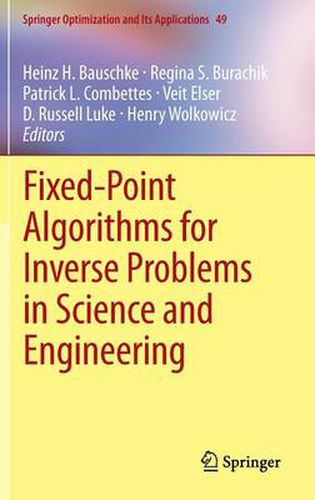Readings Newsletter
Become a Readings Member to make your shopping experience even easier.
Sign in or sign up for free!
You’re not far away from qualifying for FREE standard shipping within Australia
You’ve qualified for FREE standard shipping within Australia
The cart is loading…






This title is printed to order. This book may have been self-published. If so, we cannot guarantee the quality of the content. In the main most books will have gone through the editing process however some may not. We therefore suggest that you be aware of this before ordering this book. If in doubt check either the author or publisher’s details as we are unable to accept any returns unless they are faulty. Please contact us if you have any questions.
Fixed-Point Algorithms for Inverse Problems in Science and Engineering presents some of the most recent work from top-notch researchers studying projection and other first-order fixed-point algorithms in several areas of mathematics and the applied sciences. The material presented provides a survey of the state-of-the-art theory and practice in fixed-point algorithms, identifying emerging problems driven by applications, and discussing new approaches for solving these problems.
This book incorporates diverse perspectives from broad-ranging areas of research including, variational analysis, numerical linear algebra, biotechnology, materials science, computational solid-state physics, and chemistry.
Topics presented include:
Theory of Fixed-point algorithms: convex analysis, convex optimization, subdifferential calculus, nonsmooth analysis, proximal point methods, projection methods, resolvent and related fixed-point theoretic methods, and monotone operator theory.
Numerical analysis of fixed-point algorithms: choice of step lengths, of weights, of blocks for block-iterative and parallel methods, and of relaxation parameters; regularization of ill-posed problems; numerical comparison of various methods.
Areas of Applications: engineering (image and signal reconstruction and decompression problems), computer tomography and radiation treatment planning (convex feasibility problems), astronomy (adaptive optics), crystallography (molecular structure reconstruction), computational chemistry (molecular structure simulation) and other areas.
Because of the variety of applications presented, this book can easily serve as a basis for new and innovated research and collaboration.
$9.00 standard shipping within Australia
FREE standard shipping within Australia for orders over $100.00
Express & International shipping calculated at checkout
This title is printed to order. This book may have been self-published. If so, we cannot guarantee the quality of the content. In the main most books will have gone through the editing process however some may not. We therefore suggest that you be aware of this before ordering this book. If in doubt check either the author or publisher’s details as we are unable to accept any returns unless they are faulty. Please contact us if you have any questions.
Fixed-Point Algorithms for Inverse Problems in Science and Engineering presents some of the most recent work from top-notch researchers studying projection and other first-order fixed-point algorithms in several areas of mathematics and the applied sciences. The material presented provides a survey of the state-of-the-art theory and practice in fixed-point algorithms, identifying emerging problems driven by applications, and discussing new approaches for solving these problems.
This book incorporates diverse perspectives from broad-ranging areas of research including, variational analysis, numerical linear algebra, biotechnology, materials science, computational solid-state physics, and chemistry.
Topics presented include:
Theory of Fixed-point algorithms: convex analysis, convex optimization, subdifferential calculus, nonsmooth analysis, proximal point methods, projection methods, resolvent and related fixed-point theoretic methods, and monotone operator theory.
Numerical analysis of fixed-point algorithms: choice of step lengths, of weights, of blocks for block-iterative and parallel methods, and of relaxation parameters; regularization of ill-posed problems; numerical comparison of various methods.
Areas of Applications: engineering (image and signal reconstruction and decompression problems), computer tomography and radiation treatment planning (convex feasibility problems), astronomy (adaptive optics), crystallography (molecular structure reconstruction), computational chemistry (molecular structure simulation) and other areas.
Because of the variety of applications presented, this book can easily serve as a basis for new and innovated research and collaboration.